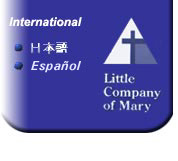
| Patient Gains New Life From A Laptop Donation |
Posted: February 6, 2001 |
Nine years ago, a bullet ripped through Alberto Diaz� neck and his life, leaving the bright, articulate 19-year-old a quadriplegic. Now 28, Diaz has been a patient at the Little Company of Mary Sub-Acute Care Center since 1994, where Regional Administrator, Post-Acute Services Division, Steve Haas noticed that he spent most waking hours on the phone, watching television or roaming the halls in his motorized wheelchair.
�Alberto needed more stimulation and he loved to communicate with others,� said Haas, �but many of our patients are not as alert and able to interact with him. Here was a young man with a vital mind trapped in a physical situation that limited his opportunities. I thought that e-mail and Internet access would give him an opportunity to �talk� with others and broaden his world. I asked myself, �What if we were able to give him that access with a laptop computer?��
Having posed the question, Haas began seeking an answer. That search led him to Linda Ciesiel, Manager of Charitable Care Services, and Lou Rotondo, R.N. and Systems Analyst in Clinical Applications at Little Company of Mary Hospital. Funding for the adaptive computer equipment was provided by funds generously donated to the Mary Potter Program for Human Dignity (MPPHD).
Rotondo used his expertise to develop a customized laptop computer system, controlled by an infrared mouse device embedded in a pair of lens-less eyeglass frames. �The device emits an infrared beam that controls the computer in a similar way to a �touch screen�,� said Rotondo, �but the light beam �touches� the infrared mouse receptor, instead of the screen itself. By programming in timed delays, Alberto can �click� on a letter or icon simply by dwelling on that point. This allows Alberto to control the computer by moving his head to direct the beam.� Rotondo also chose, installed and tested the software necessary for the system after consulting with computer instructors at El Camino College in Torrance, California.
Excited about his new communication prospects, Diaz was eager to enroll in computer classes at El Camino Community College even before his new computer was available. However, he needed a Personal Assistant to accompany him, as well as transportation to classes. Once again, the Mary Potter Program provided funds � this time on a temporary basis � for an aide and van transportation to class. (These costs now are covered by the California Department of Rehabilitation, as are Diaz� tuition and books.)
�We felt we could find funding for these expenses eventually,� explained Ciesiel, �but the Mary Potter funds enabled Alberto to start his studies while his enthusiasm was high and carried him through until we worked out the details of the laptop and ongoing funding.� Diaz now is a student at California State University, Dominguez Hills, where he is taking a full course load of computer and liberal arts classes.
While Steve Haas� �What if?� eventually became a reality, the process took time to implement. Ciesiel, Haas and Rotondo began working toward their goal in September 1999, but it was August 2000 before all the pieces came together. �In 1999, Steve asked me if I�d be interested in learning to use a computer,� explained Diaz. �I told him I couldn�t afford a computer. But he said, �Just suppose for a minute we could get you one � would you be interested?� And, sure enough, Steve came through for me.�
The persistence of Ciesiel, Rotundo and Haas has given new direction and hope to Alberto Diaz, but all three agree that the experience enriched them as well. �I got so much cooperation from others along the way in trying to make this happen,� said Haas. �It was truly a rewarding experience. When you see what a difference these programs can make in someone�s life, how can you not want to help?� |
|
|












